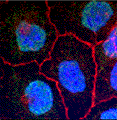Biochemistry, Department of
Document Type
Article
Date of this Version
2007
Abstract
The hyaluronic acid (HA) receptor for endocytosis (HARE; also designated stabilin-2 and FEEL-2) mediates systemic clearance of glycosaminoglycans from the circulatory and lymphatic systems via coated pit-mediated uptake. HARE is primarily found as two isoforms (315- and 190-kDa) in sinusoidal endothelial cells of the liver, lymph node, and spleen. Here we characterize the ligand specificity and function of the large stably expressed 315-HARE isoform in Flp-In 293 cell lines. Like human spleen sinusoidal endothelial cells, Flp-In 293 cell lines transfected with a single cDNA encoding the full-length 315-HARE express both the 315-kDa and the proteolytically truncated 190-kDa isoforms in a ratio of ~3–4:1. The 190- kDa HARE isoform generated from the 315-kDa HARE and the 315-kDa HARE specifically bound 125I-HA. Like the 190- kDa HARE expressed alone (Harris, E. N., Weigel, J. A., and Weigel, P. H. (2004) J. Biol. Chem. 279, 36201–36209), the 190- and 315-kDa HARE isoforms expressed in 315-HARE cell lines were recognized by anti-HARE monoclonal antibodies 30, 154, and 159. All 315-HARE cell lines could endocytose and degrade 125I-HA. Competition studies with live cells indicate that 190-HARE and 315-HARE bind HA with higher apparent affinity (Kd ~10–20 nm) than chondroitin sulfate (CS) types A, C, D, or E. Only slight competition of HA endocytosis was observed with CS-B (dermatan sulfate) and chondroitin. Direct binding assays with the 315-HARE ectodomain revealed high affinity HA binding, and lower binding affinities for CS-C, CS-D, and CS-E. A majority of each HARE isoform was intracellular, within the endocytic system, suggesting transient surface residency typical of an active endocytic recycling receptor.


Comments
Published in The Journal of Biological Chemistry 282 (2007), pp. 2785–2797; doi: 10.1074/jbc.M607787200 Copyright © The American Society for Biochemistry and Molecular Biology, Inc. Used by permission.